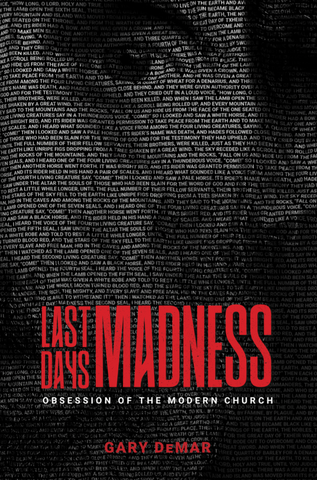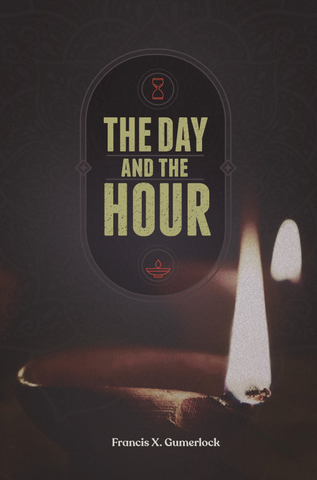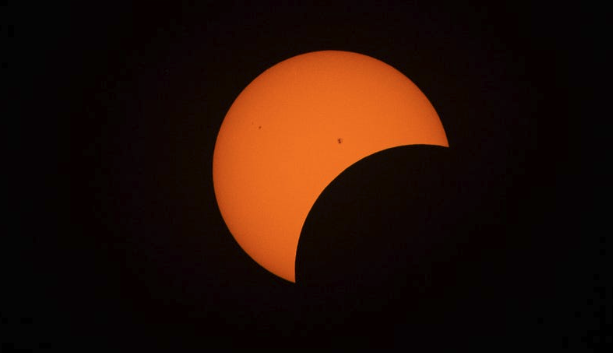It’s been embarrassing reading and listening to Christians who pushed the belief that the April 8, 2024, solar eclipse was an end-time event sign. Why do so many Christians fall for these types of end-time hoaxes? I first saw it in 1973 with Hal Lindsey’s mega-bestseller The Late Great Planet Earth. Long before Lindsey, prophetic speculation was rampant, and it’s no less true today.
It’s all over Facebook. Someone puts up what the Bible says on the subject, and hundreds (sometimes thousands) of people voice their approval. It even comes from Christians who are not sensationalists like Sam Waldron in his article “Christ Will Not Return at Any Moment” where he discusses the “delay of the Parousia.” Here are some of his responses. First, he listed Matthew 24:14. It’s obvious that what Jesus referred to was fulfilled before that generation passed away (24:34) based on what we find in Romans 1:8; 16:26; Colossians 1:6, 23, and other passages like 1 Thessalonians 8 and 1 Timothy 3:16. The Greek word often translated as “world” in Matthew 24:14 is oikoumenē not kosmos. It has the same meaning in Luke 2:1 and Acts 11:28. Waldron also mentioned 2 Thessalonians 2:1-12 because he claims it “contains Paul’s explicit teaching that the signs of the apostasy and the man of lawlessness must occur ‘first,’ and it connects these events with a period just prior to Christ’s second coming.” The temple was still standing when Paul wrote to the Thessalonians and the “man of lawlessness” was restrained then: “you know what restrains him now” (v. 6). There was an apostasy in that Apostolic generation. I cover these points and more in two chapters in my book Last Days Madness.

Last Days Madness
In this authoritative book, Gary DeMar clears the haze of end-times fever, shedding light on the most difficult and studied prophetic passages in the Bible, including Daniel 7:13-14; 9:24-27; Matt. 16:27-28; 24-25; Thess. 2; 2 Peter 3:3-13, and clearly explaining a host of other controversial topics.
Buy NowThen I saw this from Keith Tankersley who cited Isaiah 13:6-13 accompanied by the following image:

I responded with the following: “For Babylon in the Old Testament. Context matters.” I couldn’t respond to it on FB. Apparantely, he shut off comments, so I’m doing it here. The church needs a wake-up call on the topic of eschatology.
Isaiah 13 begins with this: “The oracle concerning Babylon which Isaiah the son of Amoz saw” (v. 1). Verse 6 states, “Wail, for the day of the Lord is near.” Near for whom? Babylon! Reading further, we find:
For the stars of heaven and their constellations
will not give their light.
The rising sun will be darkened,
and the moon will not give its light (v. 10).
And this:
Therefore I will make the heavens tremble,
and the earth will be shaken from its place
at the wrath of the LORD of Hosts
on the day of His burning anger (v. 13).
Let’s not forget this:
Behold, I will stir up against them the Medes,
who have no regard for silver
and no desire for gold.
Their bows will dash young men to pieces;
they will have no mercy on the fruit of the womb;
they will not look with pity on the children.
And Babylon, the jewel of the kingdoms,
the glory of the pride of the Chaldeans,
will be overthrown by God
like Sodom and Gomorrah (vv. 17-19).
Mr. Tankersley responded to my “For Babylon in the Old Testament. Context matters” with the following:
For the second coming of Christ in the New Testament too! When He comes to judge the world in righteousness, Acts 17:31. Yeah context matters! Clearly eschatology does too! Perhaps I should have used this one in the caption instead: “Then the kings of the earth and the great ones and the generals and the rich and the powerful, and everyone, slave and free, hid themselves in the caves and among the rocks of the mountains, calling to the mountains and rocks, “Fall on us and hide us from the face of him who is seated on the throne, and from the wrath of the Lamb, for the great day of their wrath has come, and who can stand?” (Revelation 6:15-17 ESV).
Looks similar to the Isaiah passage huh? Unless of course you believe this already happened? #NOTPOSTMILL
Not interested a single bit playing a ping pong match over eschatology either.
Question: Did the Sun and Moon physically go dark in Isaiah’s day? Did the heavens physically tremble? Was the earth physically shaken from its place? Did this happen when the Medes (the original context) vanquished Babylon in a single night (Dan. 5:30), because that was the nation that in earthly terms brought it about (Isa. 13:17). The language is metaphorical, something that even dispensationalists admit. For example: “The statements in 13:10 about the heavenly bodies (stars … sun … moon) no longer functioning may figuratively describe the total turnaround of the political structure of the Near East. The same would be true of the heavens trembling and the earth shaking (v. 13), figures of speech suggesting all‑encompassing destruction.”[1]
Jesus quotes the Isaiah passage in Matthew 24:29 and applies it to the judgment on that generation (24:33-34). This means that nothing physically happened to the sun, moon, or stars (Isa. 34:4). If these passages did not refer to physical changes in the cosmos when the Medes conquered Babylon and when Jerusalem fell in AD 70, are futurists claiming that at Jesus’ Second Coming that the actual Sun and Moon will go dark and literal stars will fall to the earth? If that happens, how in the premillennial view will people be reigning on Earth with Jesus?
Let’s look at Tankersley’s New Testament references. First, is Acts 17:31 describing the end of the world as we know it?
He has set a day on which He is about to [μέλλει] judge the world [οἰκουμένην] in righteousness through a Man whom He has appointed, having furnished proof to all people by raising Him from the dead.
Paul is not describing some end-of-the-world event. He was warning the Athenians that they would not escape God’s judgment. If the nation of Israel did not escape it, and Babylon, and the Medes and the Persians, and their own ancestors did not escape God’s judgment, the Athenians would not escape it either. If the threat Paul made to the Athenians is yet to happen, they could have reasoned, “This doesn’t affect us. This event is far in the future. ‘Eat, drink, and be merry for tomorrow we die’” (Isa. 22:13; Eccl. 8:15, 1 Cor. 15:32; and Luke 12:19), but the judgment is for people far distant from us.” C.K. Barrett made the following observation in his commentary on Acts 17:31: “It is implied that the day is near, otherwise the warning would carry little force.”[2] For further study on this see A.J. Mattill, Jr., Luke and the Last Things: A Perspective for the Understanding of Lukan Thought (Dillsboro, NC: Western North Carolina Press, 1979), 43-44, 45, 46, 47.
Peter establishes the nearness of this judgment: “but they will give an account to Him who is ready[3] to judge the living and the dead…. The end of all things is near…. For it is time for judgment to begin with the household of God; and if it begins with us first, what will be the outcome for those who do not obey the gospel of God? (1 Peter 4:5, 7, 17). Paul said as much in 2 Timothy 4:1: “I solemnly exhort you in the presence of God and of Christ Jesus, who is [μέλλοντος/mellontos] to judge the living and the dead, and by His appearing and His kingdom.”
Judgment is not a one-time end-time event, and in all the examples so far, not one of them was cosmic.
I’m not sure if Mr. Tankersley has thought through his appeal to Revelation 6:15-17 in defense of his end-time view. Why did he skip verses 12-14 that describe Isaiah 13-like language but then adds, “the stars of the sky/heavens fell to the earth, as a fig tree casts its unripe figs when shaken by a great wind” (v. 13). If physical stars fall to Earth, then Earth will be physically destroyed. In Revelation 12, we find this:
Then another sign appeared in heaven: and behold, a great red dragon having seven heads and ten horns, and on his heads were seven crowns. And his tail swept away a third of the stars of heaven and hurled them to the earth. And the dragon stood before the woman who was about to give birth, so that when she gave birth, he might devour her Child.
Given the physicalist interpretation, Earth was destroyed in Revelation 6 because of falling stars and destroyed again when another star “had fallen to the earth” (or land) in 9:1, and for a third time when the dragon’s tail “swept away a third of the stars of heaven and hurled them to the earth.” After these three stellar events in Revelation, Earth is still intact, so much so, given fanciful futurist arguments, to set up electronic surveillance on the world’s population!
Yes, Mr. Tankersley, it does look similar to the Isaiah passage, and because it does, it most likely applied in a similar way—a description of the judgment of a nation, not the whole wide world. Was Israel judged in a way like Babylon? Yes, it was. Jesus said it would be (Matt. 24:29) before their generation passed away. The description is hyperbolic metaphorical language, otherwise stars falling to Earth by a dragon’s tail does not make any sense.
Then there’s the timing factor (see Rev. 1:1, 3, 9; 22:10). Note this from Revelation 6:16: “Fall on us and hide us from the face of Him who is seated on the throne, and from the wrath of the Lamb, for the great day of their wrath has come, and who can stand?” Where is this found in Scripture?
And following Him was a large crowd of the people, and of women who were mourning and lamenting Him. But Jesus turning to them said, “Daughters of Jerusalem, stop weeping for Me, but weep for yourselves and for your children. “For behold, the days are coming when they will say, ‘Blessed are the barren, and the wombs that never bore, and the breasts that never nursed.’ “Then they will begin TO SAY TO THE MOUNTAINS, ‘FALL ON US,’ AND TO THE HILLS, ‘COVER US.’ “For if they do these things when the tree is green, what will happen when it is dry?” (Luke 23:17-31)
Jesus described the people of His own day. James M. Hamilton, Jr., a premillennialist, writes that “the opening of the seals in Revelation 6 corresponds to what Jesus describes in the Olivet Discourse in the Synoptic Gospels.”[4] I agree because both descriptions portray events in the lead-up to the destruction of the temple and the judgment on NT Israel in AD 70. See my books Is Jesus Coming Soon?, Last Days Madness, and Wars and Rumors of Wars, Prophecy Wars, and John Bray’s Matthew 24, Nehemiah Nisbett’s The Destruction of Jerusalem, James Jordan’s Matthew 23-25, and David Chilton’s The Great Tribulation, Paradise Restored, and The Days of Vengeance.
Jesus mentioned earlier in Luke’s Gospel, “Woe to those who are pregnant and to those who are nursing babies in those days; for there will be great distress upon the land and wrath to this people” (21:23). The barren at that time would die childless, and those who were pregnant will be in great distress because they most likely would not be able to care for their children. Josephus, an eyewitness of the horrors of the Roman siege, described a particular event:
There was one Mary, the daughter of Eleazar, illustrious for her family and riches. She having been stripped and plundered of all her substance and provisions by the soldiers, out of necessity and fury killed her own sucking child, and having boiled him, devoured half of him, and covering up the rest preserved it for another time. The soldiers soon came, allured by the smell of victuals, and threatened to kill her immediately, if she would not produce what she had dressed. But she replied that she had reserved a good part for them, and uncovered the relics of her son. Dread and astonishment seized them, and they stood stupefied at the sight.[5]
By following the lead of Scripture, “searching the Scriptures daily to see whether these things are so,” we will not be led astray by prophetic speculators who can’t seem to get it through their heads that stellar phenomena language is about local judgments on nations. Nothing physically happened to the Sun, Moon, and stars. The heavens did not physically “roll up like a scroll” or “vanish like smoke” (Isa. 34:4; 51:6; Heb. 11:11-12).
Does any of this mean that God does not judge nations anymore? Not at all. But it’s important that we do not apply fulfilled prophecy to the future. It’s been done for nearly two millennia with less than stellar results. For a history of failed prophetic speculation, see Frank Gumerlock’s book The Day and the Hour.

The Day and the Hour
In The Day and The Hour, Gumerlock spans two thousand years of conjecture on the last days, disclosing the dreams and delusions of those who believed that their sect was the 144,000 of Revelation 7; that the 1290 days of Daniel 12 had expired in their generation; that the "Man of Sin" of II Thessalonians 2 was reigning in their time; that a Rapture of the saints, a Great Tribulation, a Battle of Armageddon were just around the corner; or that a Millennial Kingdom was about to dawn.
Buy Now[1] John A. Martin, “Isaiah,” The Bible Knowledge Commentary, 1:1059.
[2] C. K. Barrett, Acts, International Critical Commentary, 2 vols. (T.&T Clark, 2004).
[3] “Eggízō expresses ‘extreme closeness, immediate imminence—even a presence (‘It is here’) because the moment of this coming happened (i.e., at the beginning of Jesus’ ministry)’ (J. Schlosser).”
[4] Hamilton, An Interview with Dr. James Hamilton. For further discussion of this point, see James M. Hamilton, Jr., Revelation: The Spirit Speaks to the Churches (Wheaton, IL: Crossway, 2012), 166-167. Also, Louis A. Vos, The Synoptic Traditions in the Apocalypse (Kampen, Netherlands: J.H. Kok N. V., 1965), 181-188.
[5] Thomas Newton, Dissertations on the Prophecies, Which Have Remarkably Been Fulfilled, and at this Time are Fulfilling in the World (London: J. F. Dove, 1754), 345‑346.

